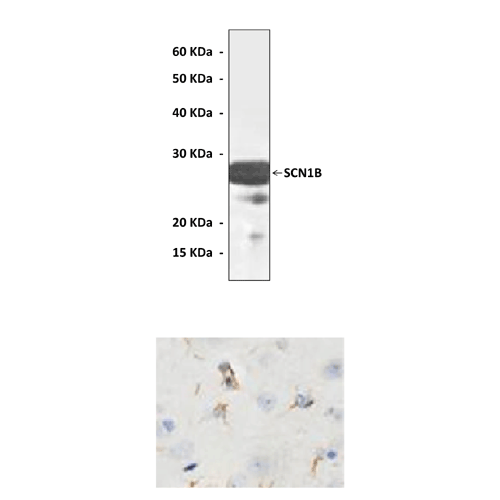Product Sheet CA1705
Description
BACKGROUND Voltage-gated sodium channels (NavCh) are glycoprotein complexes responsible for initiation and propagation of action potentials in excitable cells such as central and peripheral neurons, cardiac and skeletal muscle myocytes, and neuroendocrine cells. Mammalian sodium channels are heterotrimers and consist of a single large (approximately 260 kDa) pore-forming alpha subunit complexed with 1 or 2 smaller accessory beta subunits. Nine genes (SCN1A, SCN2A, etc.) encoding distinct alpha subunit isoforms and 4 beta subunit genes (SCN1B, SCN2B, etc.) have been identified in the human genome. Many isoforms are expressed in the central and peripheral nervous system, while skeletal muscle and cardiac muscle express more restricted NaVCh repertoires. Mutations in alpha subunit genes have been linked to paroxysmal disorders such as epilepsy, long QT syndrome, and hyperkalemic periodic paralysis in humans, and motor endplate disease and cerebellar ataxia in mice. A mutation in the beta 1 subunit gene has been linked to generalized epilepsy with febrile seizures plus type 1 (GEFS + 1) in a human family with this disease.1 Sodium channel beta subunits are multifunctional. Sodium channel beta1 subunit was encoded by SCN1B. Sodium channel beta1 subunits modulate channel voltage-dependence and gating as well as channel cell surface expression.2 Beta1 also participates in cell-cell and cell-matrix adhesion. beta1-mediated homophilic cell adhesion in vitro results in cellular aggregation, ankyrin recruitment, and neurite outgrowth. A sodium channel signaling complex is proposed that involves beta subunits as channel modulators as well as cell adhesion molecules, other cell adhesion molecules such as neurofascin and contactin, RPTP beta, and extracellular matrix molecules such as tenascin.3 In vivo, the loss of beta1 results in spontaneous seizures, ataxia, and aberrant neuronal pathfinding and fasciculation. SCN1B gives rise to at least two splice variants, beta1 and beta1B, that differ in their carboxyl-terminal domains.4
REFERENCES
1. Catterall, W.A.: Adv Neurol. 79:441-56, 1999
2. Isom, L.L.: Neuroscientist. 7:42-54, 2001
3. Isom, L.L.: Front Biosci. 7:12-23, 2002
4. Plummer, N.W. & Meisler, M.H.: Genomics 57: 323–331, 1999
2. Isom, L.L.: Neuroscientist. 7:42-54, 2001
3. Isom, L.L.: Front Biosci. 7:12-23, 2002
4. Plummer, N.W. & Meisler, M.H.: Genomics 57: 323–331, 1999
Products are for research use only. They are not intended for human, animal, or diagnostic applications.
Details
Cat.No.: | CA1705 |
Antigen: | central sequence of human SCN1B |
Isotype: | Affinity-Purified Rabbit Polyclonal IgG |
Species & predicted species cross- reactivity ( ): | Human, Rabbit, Rat, Mouse |
Applications & Suggested starting dilutions:* | WB 1:500 to 1:1000 IP n/d IHC (Paraffin) 1:50 to 1:200 ICC n/d FACS n/d |
Predicted Molecular Weight of protein: | 27 kDa |
Specificity/Sensitivity: | Reacts specifically with SCN1B of human, rabbit, mouse & rat origin in immunostaining and western blotting, no cross-reactivity with other members of the family. |
Storage: | Store at 4° C for frequent use; at -20° C for at least one year. |
*Optimal working dilutions must be determined by end user.

